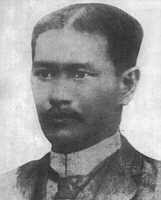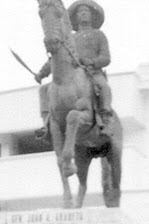A TALE OF "ARAUT" AND THE "PINTADOS" OF THE VISAYAs
"As long as we have memories, yesterday remains. Enjoy reading as we journey back in time" --Dinggol .D~~~ (DinggolAranetaDivinagracia*ILONGGO MEMORIES*Feb. 07, 2023)
PROLOGUE:
This article is written as a tribute to our early ancestors for their bold decision and pioneering spirit that eventually led to the founding of the once-upon-a-time great "Ilonggo Nation” the "Katiringban et Madya-as" or the Confederation of Madyaas."
The "Tumandok" (natives) of Dumangas in the Province of Iloilo (Philippines) are descended from the adventurous seafaring Malays who settled at Kinabatangan in "Bornay" or in north Borneo. They were originally from the small kingdom of "Panai" along the Strait of Malacca in the eastern shores of northern Sumatra in Indonesia.
PANAI (PANNAI, PANAI OR PANE)
During the 11th century, Rajendra Chola I, king of the Chola dynasty left Southern India and embarked with his troops across the Bengal Bay unto the narrow Strait of Malacca to launch the successful invasion against the Srivijaya empire in Sumatra, the largest island of Indonesia. Among those conquered was the small kingdom of Panai located with its water ponds of Lake Toba on the east coast of Northern Sumatra.
In Nagarakretagama records, Pane or Panai is mentioned as one of Sumatran kingdoms held under Majapahit influence between the 11th to the 14th centuries. Until it was abandoned by the inhabitants.
It may be traced to the sacking of the kingdom of Panai by the Chola dynasty, and that it was dissolved when the leaders together with their tribesmen sailed for Bornay (Borneo) due to the collapsing Srivijayan Empire. After staying for some time in Bornay, the former inhabitants of Panai decided to leave the tyrannical rule of the despotic reigning Rajah Makatunao.
Led by the Sultanate Minister Datu Putih bringing along their culture, language (Kinaray-a), religion, and way of life -- they sailed their balanghais northwest and landed at Aninipay in the kingdom of the Aetas or Atis ruled by Chieftain Marikudo son of the old chief Polpulon.
THE CONCRETE PROOF
Among the archaeological proofs of the existence of this exodus are artifacts found in pre-Hispanic tombs from many parts of Panay, including those in Igbaras and Oton in Iloilo. Likewise, ancient gold items excavated in the province of Antique are now on display in museums.
Another testimony of the antiquity of this civilization is the longest and oldest epic, the "Hinilawod" of the Sulodnon-Bukidnon in Central Panay Island that is still being performed even today. Anthropologist Patricia P. Magos asserts, ...the identity of the Panay-Bukidnon culture can be reconstructed through these epics which serve as their link to the ancient past"
One of the oldest artifacts found in the Philippines were remnants of Balangay or Balanghai, the Wooden Seagoing Outrigger Boat that was used by a community of settlers to travel from one place to another.
The Aetas or "Atis" (Negritos) of today --who speak with their very own "Inati" ethnic language since way back when, still call their brown brothers in the lowlands as "ang mga Bisaya" (The Visayans). A clear manifestation of the historical encounter of their forebears and the Shrivijaya or Shrivisayans of long ago. This event popularly known as the "Barter of Panay" was formerly celebrated with extravagant fun and frolics as the Kalibo "Ati-Atihan" in Aklan to commemorate the merger of two ethnic cultures.
Unfortunately, however, along the way, this was discreetly maneuvered to become a religious occasion filled with political inclination, and with massive commercial consideration. Hala Bira! Hala Bira! Viva Señor Santo Niño!
THE MARAGTAS
In 1901 Pedro Alcantara Monteclaro y Nacionales, the eldest son of Bartolome Monteclaro y Tupaz and Ramona Nacionales y Orbe of Miagao, Iloilo authored a book entitled "Maragtas" depicting the migration of the ShriVijajan Malays to Aninipay and the Barter of Panay. This is a transliteration of the 1858 manuscript by Fr. Tomas Santaren’s “Historia de los Primeros Datos Que, Procedentes de Borneo, Poblaron Estas Islas” that were based on the manuscripts of his predecessor Fr. Agustín Rico, O.S.A who was assigned as resident priest of Suarangan (San Joaquin) Iloilo in 1801.
The MARAGTAS was published in 1907 by the illustrious Lawyer Salvador Laguda of Mambusao, Capiz who was an Economist, a Journalist, a big time Sugar Planter, and a Politician among others.
The Maragtas legend explained and the ancient Chinese Ming Dynasty Chronicle confirmed; that sometime between the 13th and 15th century, ten (10) Sri-Vishayan datus together with their families, households and subordinates fled Bornay (Borneo) in search of a new life.
Led by the Sultanate Minister Datu Putih they sailed their “balangay” a.k.a. “balanghai” unto uncertain fate and landed at Sirwagan/ Siwaragan in (San Joaquin-Iloilo) in the island of Aninipay (Panay). They bartered their gold and jewelry with the local "Ati" Chieftain Marikudo for the lowlands, plains and valleys of the island they called "Madya-as" or paradise. The land where time began the birth of the Ilonggo Nation and the cradle of an ancient Filipino civilization. To retain the memory of their homeland in Sumatra, Indonesia they renamed the island into "Panai" known today as "Panay", dubbed as the heart of the Philippines.
THE SPANISH ERA (Tiempo Español)
In the island of Panay, the existence of highly developed and independent principalities of Ogtong (Oton) and of Araut (Dumangas) was well known to early Spanish settlers in the Philippines. The Augustinian historian Gaspar de San Agustin, O.S.A. for example, wrote about the existence of an ancient and illustrious “nobility in Araut”, in his book Conquistas de las Islas Filipinas (1565–1615).
He said: "También fundó convento el Padre Fray Martín de Rada en Araut- que ahora se llama el convento de Dumangas- con la advocación de nuestro Padre San Agustín...Está fundado este pueblo casi a los fines del río de Halaur, que naciendo en unos altos montes en el centro de esta isla (Panay)...Es el pueblo muy hermoso, ameno y muy lleno de palmares de cocos. Antiguamente era el emporio y corte de la más lúcida nobleza de toda aquella isla." Gaspar de San Agustin, O.S.A., Conquistas de las Islas Filipinas (1565-1615), Manuel Merino, O.S.A., ed., Consejo Superior de Investigaciones Científicas: Madrid 1975, pp. 374-375.
THE CASE OF DATU PUTIH AND THE BARTER OF PANAY AS A "HOAX"
In 1968, William Henry Scott, a retired lay missionary of the Episcopal Church from New Jersey, USA arrived in Manila. In a short span of his stay in the Philippines, and without even stepping on Panay soil, he theorized that the historicity of Maragtas and the Barter of Panay was a "hoax".
Sad to say, some of our countrymen were convinced by the foreigner WILLIAM HENRY SCOTT to renounce as to the veracity of their very own cultural heritage. Worst of all, accepting Scott's opinion, it was stricken-out in school text books by the Manila-based Philippine Educational System. Just like the "Good Manners and Right Conduct" an important separate subject in elementary grades which was also later stricken-out in school curriculum.
WILLIAM HENRY SCOTT'S "REVISED" VERSION - 1984:
Scott himself had no doubt regarding the historicity of an event that led to the transmission of an oral tradition that came to be known as the "Maragtas". He said in the revised version of his doctoral dissertation, published in 1984: "There is no reason to doubt that this legend preserves the memory of an actual event, but it is not possible to date the event itself or to decide which of its details are historic facts and which are the embellishment of generation of oral transmission."
HISTORIA DE LA PROVINCIA DE BATANGAS
William Henry Scott and his colleagues were unaware that there is an existing unpublished ancient manuscript of Fray Pedro Andres de Castro called "Historia de la Provincia de Batangas" (1790), which is strikingly similar to "Historia de los primeros Datos..." of Fr. Tomas Santaren (1858). The author of Osario Venerable Fr. Agustin Maria de Castro a.k.a. Pedro Andres de Castro was the priest of the Pueblo of Calinog (Iloilo) during 1764.
Fr. Agustin Maria de Castro was a librarian during the British invasion of San Agustin Convent in Manila when he transferred to Panay. He brought all his books and manuscripts to Iloilo. For centuries the manuscript "Historia de la Provincia de Batangas" was in the convent of the Immaculate Conception Parish in Bauan. They turned over the manuscript to an archive in Manila a few years ago. (Jigger Gilera, MD., MHA-Local Historian, Mabini Historical Society)
ARAUT (DUMANGAS)
After partitioning Madya-as into Akean (Aklan & Capiz), Irong-irong (Iloilo), and Hamtic (Antique) to be ruled by Datus Bankaya, Paiburong and Sumakwel respectively; Datu Putih and the other tribal leaders settled along the banks of the river by the sea with rich, fertile soil and abundant marine products and they called the place "Araut", meaning near the sea.
Thereafter, the council of elders established the "Katiringban et Madya-as" or the Confederation of Madyaas headed by Datu Sumakwel. This confederated political form of governance preceded many great nations in Europe and the Americas.
Datu Putih accompanied by Datu Balinsusa and Datu Dumangsil together with their tribesmen decided to leave Araut and sailed farther north towards "Selorang Lusong" passing the Island of Mindoro until they reached the mouth of Taal (Batangas) river and there, set up the first Malay settlement in Luzon that eventually spread along the coastal areas in Batangas.
In the year 1570, Kapitan Juan de Salcedo, grandson of the "El Adelantado" Miguel Lopez de Lagaspi --as second in command to Spanish conquistador Martin de Goiti, together... explored the coast of Batangas on their way to "Maynilad" and came upon this existing ancient Malay settlement. Two years later, the town of Taal in Batangas was founded.
THE PINTADOS OF THE VISAYAS
Datu Putih was the supreme leader, and the following Srivijaya Datus served as head of the Katiringban et Madya-as (based at): Datu Sumakwel (Hamtic); Datu Bangkaya (Akean); Datu Paiburong (Irong-irong); Datu Balengkaka (Akean); Datu Kalantiaw (Akean); Datu Manduyog (Akean); Datu Padojinog (Irong-irong); and Datu Madnayag (Akean).
Chinese accounts: “To the Chinese, the people of the Confederation of Madyaas were known as "Pisheya''. This is a transliteration of the general geographical location of the Confederation of Madyaas, the Visayan islands. This confederation reached its peak under Datu Padojinog. During Padojinog’s reign the confederations' hegemony extended over most of the islands of Visayas. In 1612, the Chuan-chou gazetteer specifically reported that the Pisheya consistently made piratical raids along the shorelines of mainland China and against Chinese shipping that impeded Imperial commerce.
The daring seaborne Visayan warrior-raiders locally known as “ mga Pangayaw” or the adventurers were the “Pintados”, whose body were tattooed with intricate designs, and are believed to have come mostly from the old town of Passi in Iloilo and from the island of Leyte.
Even today, Passi City (my birthplace) in Iloilo celebrates the daring saga of their forebears with the annual “Pintados de Passi Festival” held every 3rd week of March in honor of the Pintados who once inhabited the town. Likewise, in Leyte the “Pintados-Kasadyaan Festival” is held annually on June 29th in Tacloban City.
Epilogue:
CLICK FOR MORE! Pishea/Pintados @ https://www.youtube.com/watch?v=N9SI37ZjpHc&feature=share...
(Source: Glimpses of Ilonggo History, Etc. at https: //www.facebook.com/groups/2470058109983695/
(Photos and video from Google search engine)






















No comments:
Post a Comment